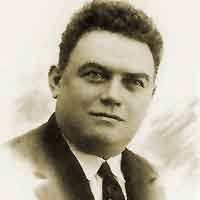Soutullo was born in Puenteáreas, Pontevedra on 11th July 1880 – into a musical family, for his father was director of the local Municipal Band of Arena. Soutullo senior gave his son a thorough musical grounding, before handling him on to local pedagogue Fernández Cid for more advanced tuition. By the age of fourteen the youngster was already competent enough to be directing the chorus in the nearby Tuy, and two years later he obtained the posting of cornet soloist with the 37th Murcia Infantry Regiment. Here he received further harmony lessons from the Bandmaster, Cetina, before moving on to the Madrid Conservatory.
Starting part time in 1900 (full time two years later) Soutullo won First Prizes for harmony and composition, studied under Pedro Fontanilla and Tomás Fernández Grajal respectively. After graduating in 1906, he was able to take up scholarships to study in Italy, France with Ravel and Saint-Saens, Switzerland and Germany before returning to Madrid in order to make his way as a composer – a prospect all the more promising, as his compositions (over one hundred in all forms) had attracted the favourable notice of Ruperto Chapí. He soon began to make his mark with collaborative zarzuelas such as La paloma del barrio (1911, with Andreu), Amores de aldea (1915, Luna), Rosa de Flandes and Piso 5° Letra C (both with Enrique Estela).
In 1919 he began the famous musical partnership with Juan Vert, which continued until the latter’s early death in 1931. El capricho de una reina (1919) was their first joint work, but – like their first great success, Guitarras y bandurrias (1920) – it is now all but forgotten. Not so La leyenda del beso (1924), nor La del soto del Parral (1927, to a libretto by Carreño and de Sevilla), both of which maintain their hold in the repertoire. Other popular successes, such as Encarna, la misterio (1925) and the revue Las maravillosas (1928) have dimmed with time, but their final theatre triumph together, El último romántico (1927) is still held in great affection for its gently lilting, Viennese-style melodies and easy charm.
Soutullo did not long survive his younger collaborator, dying after a car accident in Vigo on 29th October 1932. Aside from the works with Vert, he was solely responsible for an opera La devoción de la Cruz, and the symphonic suite Vigo, both of which are marked by fastidious orchestral craftsmanship and Gallic shifts of harmony. It is difficult to say which of the two composers was responsible for the various strengths of their work together. Well-defined in musical atmosphere, rich in melodic succulence, sophisticated in harmonic and orchestral resource – all three of the major zarzuelas (perhaps pre-eminently La leyenda del beso with its strong verismo passions) seem guaranteed a place in the hearts of zarzuela aficionados for many years to come.


10 thoughts on “Kaminos”
Was Nicholas related to Alexander Saslavsky who married Celeste Izolee Todd?
Anyone have a contact email for Yair Klinger or link to score for Ha-Bayta?
wish to have homeland concert video played on the big screen throughout North America.
can organize here in Santa Barbara California.
contacts for this needed and any ideas or suggestions welcomed.
Nat farber is my great grandpa 😊
Are there any movies or photos of max kletter? His wife’s sister was my stepmother, so I’m interested in seeing them and sharing them with his wife’s daughter.
The article says Sheb recorded his last song just 4 days before he died, but does not tell us the name of it. I be curious what it was. I’d like to hear it.
Would anyone happen to know where I can find a copy of the sheet music for a Gil Aldema Choral (SATB) arrangement for Naomi Shemer’s “Sheleg Al Iri”. (Snow on my Village)?
Joseph Smith
Kol Ram Community Choir, NYC
שלום שמעון!
לא שכחתי אותך. עזבתי את ישראל בפברואר 1998 כדי להביא את בני האוטיסט לקבל את העזרה המקצועית שלא הייתה קיימת אז בישראל. זה סיפור מאוד עצוב וטרגי, אבל אני הייתי היחיד עם ביצים שהביא אותו והייתי הורה יחיד בשבילו במשך חמישה חודשים. הוא היה אז בן 9. כעת הוא בן 36 ומתפקד באופן עצמאי. נתתי לו הזדמנות לעתיד נורמלי. בטח, אבות כולם חרא, אומרים הפמינציות, אבל כולם צריכים לעבוד כמטרות במטווחי רובה!
משה קונג
(Maurice King)
Thank you for this wonderful remembrance of Herman Zalis. My late father, Henry Wahrman, was one of his students. Note the correct spelling of his name for future reference. Thank you again for sharing this.
Tirza Wahrman (Mitlak)
amazing zchuso yagein aleinu, he wrote the famous niggun Lefichuch that is sung in almost every Israeli Yeshiva